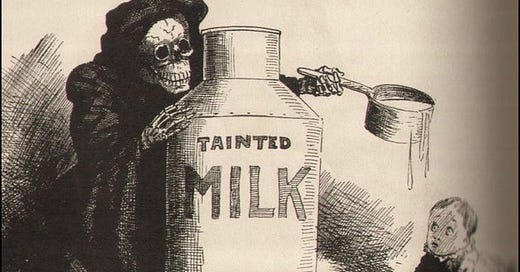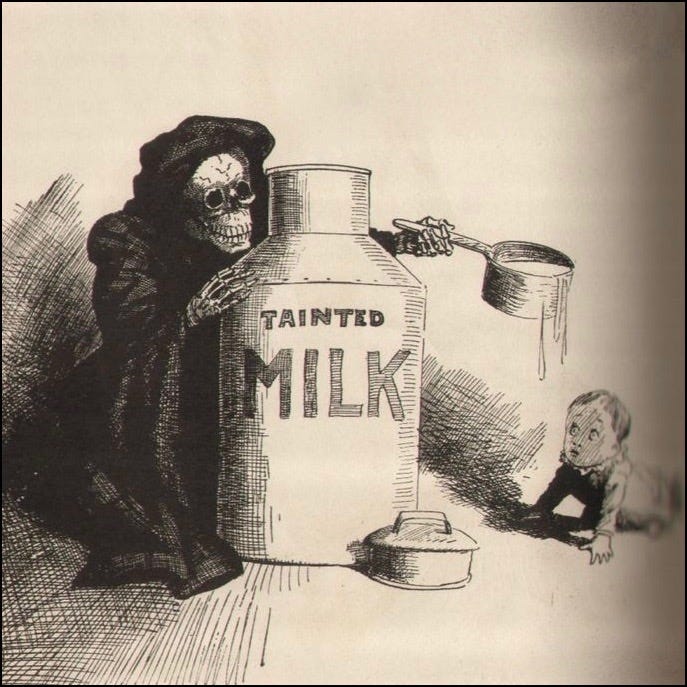How Raw Milk Changed Your Children’s Food Security -- Part 2
This 4-part article explores how the 1987 ban came about and what it means to your food security today
A “scientific” ideology banned raw milk and vilified mothers who chose it anyway. Behind this, was a wealthy philanthropist pushing his agenda and setting the stage for the demise of the small farmer and food security in America.
The Entangled Relationship Between War, Whisky, and Milk
You are probably asking “What does whisky have to do with milk?”
We must understand whisky production in America to understand our history with milk.
In 1800s America, high taxes (to pay for the Revolutionary War) on imported spirits led to the rise of whisky distilleries in America. American farmers said “We can do this!” and they did. American whisky skyrocketed in popularity and production.
Whisky distilleries popped up everywhere. Even in certain cities. Transportation was a big cost, so putting the distilleries near the people seemed like a good idea. Disposing of the spent grain used to make whisky was expensive and cumbersome. This led to the concept of putting dairies right next to the distilleries and feeding the cows the spent grain from the whisky-making process.1 Spent grain is not a cow's native food. Her native food is a diversity of grasses, while she roams the fields in the sunshine.
For those profiting from both the whisky and the milk, this seemed like a great idea. However, these abominations on agriculture led to disastrous results for cows and humans.2
What ensued from this situation was predictable. The cows spent most of their short miserable lives indoors, in filthy conditions, unhealthy and producing milk that was of terrifying quality. There were no closed milking systems at the time. Workers hand milked into open pails.
This milk became known as “swill milk.”3
It is not shocking that infant mortality was unacceptably high during this period. Sanitation was poor, there were no closed milking systems and no refrigeration. Public voices began to implicate the milk from the distillery dairies as a factor in the infant mortality rate.
This tragic situation had an easy-enough solution: stop feeding cows spent grain. Return cows to their native diets. Give them adequate lives out on pasture, and provide clean milking conditions. Have healthy workers milking the animals. Bring clean milk to the cities from the surrounding countryside.
But that was not the proposed solution.
A Wealthy Philanthropist “Saves” The Children
By the late 1800s, Nathan Strauss, a wealthy philanthropist and co-owner of Macy’s department store, advocated for and then subsidized the pasteurization of all milk in New York City.
Several doctors spoke out against this policy noting that clean raw milk was highly nutritious and great for children. Leading the campaign for clean raw milk was Dr. Henry Coit. He saw the terrible conditions of the “distillery dairies,” and the health consequences that were blamed on the raw milk. He proposed an entirely different solution: establishing a “Medical Milk Commission” that would have doctors certify raw dairies outside the city. These doctors would ensure the farms had clean practices and produced healthy, safe milk.
His approach was a decentralized approach to feeding communities. Farmers remained in control of their own farms, the Medical Milk Commission simply became a certifying agent.
Many doctors participated in this endeavor and they had great results.
These doctors advocated for proper nutrition for children and proper animal husbandry. The results were a win-win.
But Strauss’ argument against this was that certified clean raw milk was more expensive than Strauss’ subsidized, “efficient” pasteurized milk. It was often double or quadruple the cost of the swill milk or the subsidized, pasteurized milk that Strauss offered.
The obvious solution is a dual approach. But that is not what happened.
The “public health” campaign, backed by Strauss' deep pockets, prevailed. Pasteurization won out on the better “efficiency” although most all players recognized that certified clean raw milk was the better option. (One can only wonder what types of influence Strauss’ “philanthropy” led to.)
What ensued was a decades-long battle. Many doctors advocated for clean raw milk. Those in Strauss’ camp campaigned for “public health” and compulsory pasteurization without focusing on the underlying quality of the product.
The doctors who advocated for clean, certified farms were vilified, ridiculed, and bullied. The “public health advocates” who spoke about the dangers of raw dairy and pushed for mandatory pasteurization shifted policy in many cities.
Unfortunately, it didn’t stop there.
Part 3 — The Rise Of Propaganda
A thorough history of whisky in America. https://americanwhiskeytrail.distilledspirits.org/american-whiskey-history
“Distillers’ and Cattle Feeders’ Trust” https://inthespiritofthelaw.com/2019/12/25/the-whiskey-trust/
Much of the research for this section came from this book: Schmid, Ron ND. The Untold Story of Milk. First edition, New Trends Publishing, 2003





